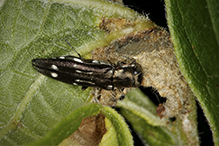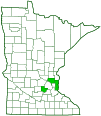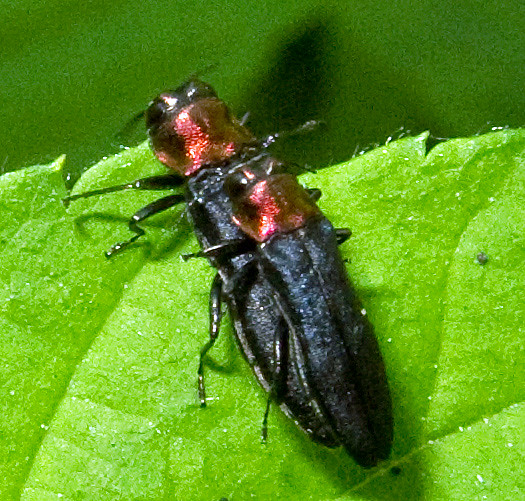beech borer
(Agrilus obsoletoguttatus)
Conservation • Description • Habitat • Ecology • Distribution • Taxonomy
|
|
||||||||||||||
Description |
Beech borer is a metallic wood-boring beetle. It is common in eastern United States and adjacent Canadian provinces. It is uncommon in Minnesota, where it is at the western edge of its range. It is small to medium-sized, much smaller than emerald ash borer. Adults are 3 ⁄16″ to 5 ⁄16″ (4.7 to 8 mm) long and bronzish-black to greenish-brown. They sometimes have a weak purple iridescence. The upper plate covering the prothorax (pronotum) is wider than long, is narrowed in the middle, and has a distinct lateral margin. The lateral margin has straight sides and does not narrow in the middle. There is a distinct ridge on each side of the pronotum at the shoulder (humeral) region near the base of the wing cover (elytron). The elytra are slightly narrowed before the middle and tapered beyond the middle toward the tips. The tips are separated, broadly rounded, and finely toothed. Toward the tip the inner margins are slightly elevated. There are three or four patches of yellow or white hair-like outgrowths on each elytron and on each side of the abdomen. On the elytron there is a round patch near the front (anterior) margin in the humeral region; a round patch toward the tip; and a short, narrow stripe in the middle toward the inner margin. The stripe is often more or less interrupted. There is often a small round patch toward the outer margin behind (posterior to) the stripe. The upper side of the abdomen is black. The last segment of the abdomen has a faint ridge on top (dorsally) but does not have a spine at the tip. The antennae are short, extending only to about the middle of the pronotum. They are sawtoothed from the fourth segment to the tip. The larvae are known as flat-headed wood borers. They are elongated, narrow, slightly flattened, and whitish. The first segment of the thorax is widened and has a horny, plate-like surface with a line down the middle. This widened segment is the source of the common name of wood-boring larvae. It has no legs but has a pair of forcep-like spines at the rear end of the abdomen. |
Size |
Total length: 3 ⁄16″ to 5 ⁄16″ |
Similar Species |
Habitat |
Hardwoods |
Ecology |
Season |
May to July |
Behavior |
|
Life Cycle |
|
Larva Food |
Roots, trunks, and branches of hardwoods, including birch, elm, ironwood, maple, oak, and walnut |
Adult Food |
Leaves of the same plants as the larvae |
Distribution |
||
|
Sources Biodiversity occurrence data published by: Minnesota Biodiversity Atlas (accessed through the Minnesota Biodiversity Atlas Portal, bellatlas.umn.edu, 6/14/2025). Hallinen, Marie J; Steffens, Wayne P; Schultz, Jennifer L; Wittman, Jacob T; Aukema, Brian H. (2021). The Jewel Beetles of Minnesota. Retrieved from the University Digital Conservancy, https://hdl.handle.net/11299/218928. |
|
| 7/16/2025 | ||
Occurrence |
||
|
||
Taxonomy |
|
Order |
Coleoptera (Beetles) |
Suborder |
Polyphaga (Water, Rove, Scarab, Long-horned, Leaf, and Snout Beetles) |
Infraorder |
Elateriformia |
Superfamily |
Buprestoidea |
Family |
Buprestidae (jewel beetles) |
Subfamily |
Agrilinae |
Tribe |
Agrilini |
Subtribe |
Agrilina |
Genus |
|
Subgenus |
|
Subordinate Taxa |
|
|
|
Synonyms |
|
Agrilus interruptus |
|
Common Names |
|
beech borer |
|
Glossary
Elytra
The hardened or leathery forewings of beetles used to protect the fragile hindwings, which are used for flying. Singular: elytron.
Pronotum
The exoskeletal plate on the upper side of the first segment of the thorax of an insect.
visitor Photos |
||
Share your photo of this insect. |
||
This button not working for you? |
||
Alfredo Colon |
 |
MinnesotaSeasons.com Photos |
||
|
||
|
||

visitor videos |
||
Share your video of this insect. |
||
This button not working for you? |
||
|
Other videos |
||
|

Created 10/30/2018 Last Updated: © MinnesotaSeasons.com. All rights reserved. |




